
Rutman Productions 1/32 FW-190A-8
|
KIT # |
? |
|
PRICE: |
$85-95 |
|
DECALS: |
One option |
|
REVIEWER: |
Erik Whipple |
|
NOTES: |
Out of Productions, aftermarket decals used |

|
HISTORY |
The volume of literature covering the Fw190 in all it’s manifestations and it’s combat record would fill up most public libraries, so this article will deal mostly with distinguishing features of day fighter variants in the A series. In 1937, an argument raged between the technical branch of the German Air Ministry (RLM) and the office of the Inspekteur der Jagdflieger. It seems few could agree on the wisdom of keeping the Messerschmitt Bf109 series as Germany’s sole single engine fighter program.
Those wishing to
diversify the inventory prevailed and in 1938 a contract for a series of
fighter prototypes was awarded to Focke-Wulf. The contract stipulated
that the aircraft be fitted with a more powerful engine than the
Daimler-Benz 600 & 601 power plants, then in production. The Focke-Wulf
design team led by Kurt Tank settled on the 14-cylinder BMW 139, as it
was the only available power plant suitable for a single engine fighter
that promised to outperform the Daimler-Benz series. It was a promise
that in some ways would go unfulfilled right to war’s end; several former
Luftwaffe pilots have lamented the relatively poor performance of the BMW
at altitudes greater than 20,000 feet. This power loss would prove
detrimental in 1943 and spur the development of a separate series of
prototypes fitted with Jumo inline engines that ultimately became the
Fw190D-9 and Ta-152, but that’s another story. The
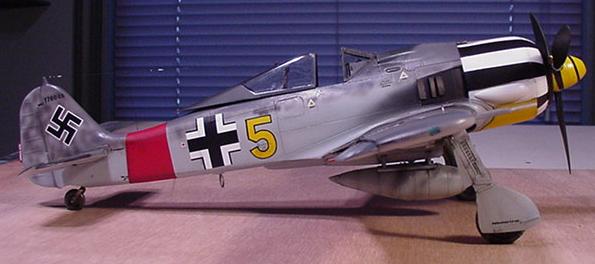 wide track landing
gear, roomy cockpit with excellent visibility, and heavier armament would
nonetheless make the Fw190A an instant favorite among many German
pilots.
wide track landing
gear, roomy cockpit with excellent visibility, and heavier armament would
nonetheless make the Fw190A an instant favorite among many German
pilots.
The first prototype, the Fw190V1, began flight-testing in May 1939. After significant teething trouble with both the BMW 139 and early BMW 801’s installed in several subsequent prototypes at the Rechlin facility, the Fw190A-0 was produced. RLM’s Technical Office wanted expert ground-truthing involved in making the Fw190 ready for full production and eventual combat. Battle hardened veterans of Jagdgeshwader 26, Oberleutnants Otto Behrens, Kapitaen of 6./JG26, and Karl Borris, the Geshwader Technical Officer, were ordered to Rechlin in the spring of 1941 to assist the process.
From the outset, the Fw190 was intended to be a multi-role fighter. Through the summer of 1941, the A-0 airframes at Rechlin were tested with different combinations of rifle-caliber MG17 and 13mm MG131 machine guns, ETC racks for bombs or drop tanks, and WkNr. 0022 was even fitted with a rudimentary ejection seat. The cooling fan, without which any Wurger would look incomplete, was also introduced, but serious engine overheating would continue to plague the type until the BMW 801c appeared in the Fw190A-2 later that year. In the midst of all this testing and development, a small number of Fw190A-1’s armed with MG17s in the cowl and outer wing positions and MG131s in the wing roots were completed. A weapon servicing hatch appeared in the shape of a pronounced polygonal pan separate from the flush ejection port under the outer wing armament. These aircraft were sent to JG-26 at Abbeville for operational evaluation. In November, the unit used its new Wurgers to deftly handle a large number of Spitfires over Gravelines, downing three without loss. German Secret Service intercepts indicated that the British may have been more impressed with the mysterious new radial engine fighter than were the personnel of JG-26, who complained vehemently about both the cantankerous powerplant and the often unbearable heat that would build up in the cockpit. In fact, the heat was so intense that on a few occasions it even caused the ammunition for the cowl-mounted MG-17s to cook off before the aircraft even got a chance to taxi out.
That winter,
the arrival of sufficient quantities of the BMW 801c and further
development would result in the Fw190A-2. Later examples of this variant
introduced the kiemenspalten, cooling slots, just forward of the cockpit
behind the side exhaust ports which had proven to mitigate the
overheating on A-0 WkNrs 0014, 0015, and 0025. The spring of 1942
would see the BMW801c powered Fw190A-2 and BMW801d-2 powered Fw190A-3
replace the Bf109 in JG2 and JG26, along with II, III, and IV/JG-1.
JG5, 11, 51, 54, SG1 and 2, and SKG10 would soon receive them as w ell.
While 226 airframes had been completed in 1941, production of the Fw190
increased sharply to 1,918 in 1942 with no less than 13 plants dedicated
to the type. The Fw190A-4 appeared virtually simultaneously with
the A-3 and it is very common to see both together in photographs from
mid-1942 and well into the following year. Externally, the A-4 can
be distinguished from the A-3 by its triangular antenna post on the tail
and 20mm MG/FF cannons in the outer wing positions and while all A-3
models had cooling slots, the last 100 or so A-4 airframes had these
replaced by rectangular flaps which would become standard on the A-5.
ell.
While 226 airframes had been completed in 1941, production of the Fw190
increased sharply to 1,918 in 1942 with no less than 13 plants dedicated
to the type. The Fw190A-4 appeared virtually simultaneously with
the A-3 and it is very common to see both together in photographs from
mid-1942 and well into the following year. Externally, the A-4 can
be distinguished from the A-3 by its triangular antenna post on the tail
and 20mm MG/FF cannons in the outer wing positions and while all A-3
models had cooling slots, the last 100 or so A-4 airframes had these
replaced by rectangular flaps which would become standard on the A-5.
In November 1942, the Fw190A-5 was beginning to take shape on factory floors. The BMW801d-2 was moved forward by 9.7cm, the upper cowl and fuselage sides lengthened, and a curved crescent-shaped fillet inserted between the wing root and the engine cowl. Photographs of many Fw190A-5s show that the outer wing armament was deleted, its punch reduced to 1 pair each of MG17s, and MG131s. Modelers are advised to check their photos closely when building this variant in order to determine the appropriate armament. In response to the increasing weight and depth of allied bombing raids both night and day as well as a serious proliferation of the heavily-armored IL-2 Sturmovik on the eastern front, 1943 would see a vast array of heavy weapons tested on the Fw190A-5. Although some had been fitted for operational use on the Fw190A-4, particularly the 21cm Werfer-Granate rockets, most would not appear as standard equipment until the arrival of the Fw190A-6.
In outward appearance, the A-6 differed very slightly from the A-5, the main stock difference being the addition of a pair of the long-barreled MG151/20 in the outer wing positions. The servicing hatch under these was changed to a flat variety that incorporated a rectangular blister containing an ejection chute for the spent brass. Internal wing structure was beefed up in order to support the heavier weapons load and resulted in the rivet pattern being changed somewhat. Late in this series the wheel covers were also changed to the dish-shaped non-perforated variety that would become standard on later models. Some of the these aircraft were indeed very heavily armed, particularly the A-6/R1, in which the MG151/20s were removed in favor of four of them paired up in WB151 pods slung under each wing; JG-11 received and used several of these in operations.
 The Fw190A-7
represents a brief transition from the A-6 to the A-8. The main
difference was the replacement of the MG17s with a pair of 13mm MG131s
and the familiar bulged upper cowl. Along with this modification, the
six Zu fittings on the upper engine cowl were switched from inboard side
of the upper panel edges to the outboard side, where they recessed into
the panels when closed. One reference from Rodeike indicates that the
aftermost pair remained inboard on the A-7, but I’ve not been able to
verify this in any other documentation that I have available. The pitot
tube was moved to the starboard wingtip. Four MG151/20s remained the
standard wing armament. At Rechlin, one Fw190A-5 (V51) had been fitted
with the short-barreled 30mm MK108 in the outer wing position and was
probably the first Fw190 to sport the convex rectangular fairing added
chordwise to the upper wing. In the spring of 1944, the first of the
Fieseler-built Sturmbocks were issued to Major Kornatzki’s Sturmstaffel
and carried MK108 cannons in the outer wing positions as the
Fw190A-7/R2. Outfitted with a small number of these and their more
lightly armed A-6’s, at least one Fw190A-6/R2 (Wr.Nr. 530765) has been
identified among the inventory of Sturm 1 at the time. The Fw190A-7/R2
would serve mainly with Sturm 1. In the early summer, Kornatzki acted on
orders to disband the staffel and dispatched his pilots to form the
kernels of II (Sturm)/JG4, II (Sturm)/JG300, and IV (Sturm)/JG3. Using
the Fw190A in the heavy fighter role, these units would usually be
escorted by formations of Bf109s of the G-6/AS, G-14/AS, and early G-10
series which were at the time the only common luftwaffe fighters that
stood any chance of holding their own with the Mustangs of the 8th
Air Force.
The Fw190A-7
represents a brief transition from the A-6 to the A-8. The main
difference was the replacement of the MG17s with a pair of 13mm MG131s
and the familiar bulged upper cowl. Along with this modification, the
six Zu fittings on the upper engine cowl were switched from inboard side
of the upper panel edges to the outboard side, where they recessed into
the panels when closed. One reference from Rodeike indicates that the
aftermost pair remained inboard on the A-7, but I’ve not been able to
verify this in any other documentation that I have available. The pitot
tube was moved to the starboard wingtip. Four MG151/20s remained the
standard wing armament. At Rechlin, one Fw190A-5 (V51) had been fitted
with the short-barreled 30mm MK108 in the outer wing position and was
probably the first Fw190 to sport the convex rectangular fairing added
chordwise to the upper wing. In the spring of 1944, the first of the
Fieseler-built Sturmbocks were issued to Major Kornatzki’s Sturmstaffel
and carried MK108 cannons in the outer wing positions as the
Fw190A-7/R2. Outfitted with a small number of these and their more
lightly armed A-6’s, at least one Fw190A-6/R2 (Wr.Nr. 530765) has been
identified among the inventory of Sturm 1 at the time. The Fw190A-7/R2
would serve mainly with Sturm 1. In the early summer, Kornatzki acted on
orders to disband the staffel and dispatched his pilots to form the
kernels of II (Sturm)/JG4, II (Sturm)/JG300, and IV (Sturm)/JG3. Using
the Fw190A in the heavy fighter role, these units would usually be
escorted by formations of Bf109s of the G-6/AS, G-14/AS, and early G-10
series which were at the time the only common luftwaffe fighters that
stood any chance of holding their own with the Mustangs of the 8th
Air Force.
The Fw190A-8, with production beginning in February 1944, would become the most numerous variant with a total of 1,344 airframes delivered. These can readily be distinguished from the A-7 since the rack for the drop tank was moved forward by 20cm in order to counter the weight a 115 litre GM-1/MW50 tank installed in the fuselage behind the pilot seat. A large rhomboid access panel appeared on the underside of the fuselage between the trailing edges of the wing fillets and a servicing panel and fill point were added on the starboard fuselage side as well. The large ventral hatch provided access to both the power boost system and the oxygen bottles. MG131s in the cowl and two pairs of wing mounted MG151/20s remained the standard armament, but in the summer of 1944 a growing number of R2 variants armed with the 30mm Mk108 began to replace the A-7 heavy fighters in IV./JG3 and II./JG300; IV./JG4 also received them. The last of the A-series was the A-9, distinguishable from other variants by its blown canopy and revised head armor of the type developed for use in the Dora series and Ta-152. Alongside those two higher performing inline Jumo-powered machines, the Wurger would continue to take its toll among allied formations, and in the process carry many an unfortunate jagdflieger to his death right up to war’s end.
|
THE KIT |
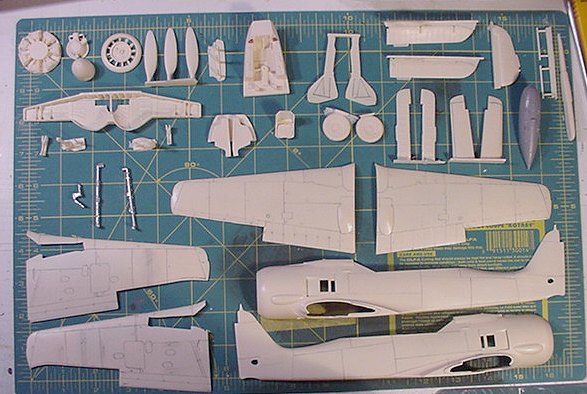
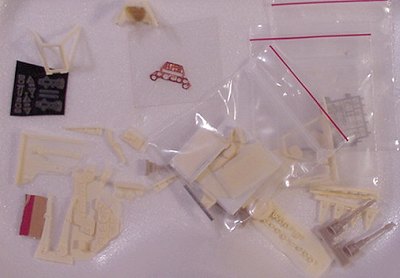
The 1/32nd Rutman Fw190 kits are very accurate in outline, detail, and scale dimension. In my opinion, they are much better representatives of the type than any of the offerings from styrene kit manufacturers to date in large scale. While the main bits are composed of beautifully molded resin covered by perfect recessed panel lines and all the bulges in the right places, they include a number of bagged white metal and photoetch parts along with pieces of Plexiglas and acetate for the windscreen, as well as a vacuform canopy. The kit has been produced with various combinations of additional parts in order to create almost any sub-type of the Fw190A-8. While Rutman has decals available for the JG-54 machine flown by Robert “Bazi” Weiss, Eagle Strike makes a set with three options, and Mike Grant may still have some 1/32nd unit markings and stencils available.
|
CONSTRUCTION |
As this was my first attempt at a resin kit, I started by thoroughly studying the instructions and surveying all the parts to make some basic decisions and plan the order of assembly. Light resin flash was removed, all resin parts washed using a soft cloth and a warm solution of dish soap. After they were dry, all the parts were grouped into small containers by subassembly. I could see from the outset that the single most important factor in the construction of the model would be the correct orientation of the one-piece wheel well within the fuselage halves. Some careful sanding and test-fitting on both the outer surfaces of the wheel well and corresponding areas of the fuselage wing fillets gave me what I was after. Just to be sure, I test-fitted the 7 critical pieces comprising the wheel wells, fuselage halves, and wings during this process.
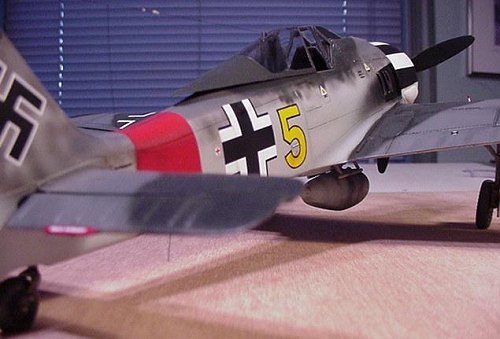 Thin bulkheads
cover the side and ventral exhaust ports, presumably to avert the risk of
mold flaws which would affect the outline of the cow, l and these were
easily opened by drilling into them with a pin vise at about a 30 degree
angle to the fuselage centerline and then cleaned up with a sharp hobby
knife. Engraved lines on the fuselage represent the cooling flaps; I
elected to open up these areas with a hobby knife and installed curved
Evergreen stock to represent the flaps in the open position. After
locating a pounce wheel at a local arts & crafts store, I also
experimented with some riveting just for kicks. This was not entirely
successful since the tool I bought was really not up to the task, so I
went back and reshaped the rivets with a point scriber. I found that
with a little test fitting and minor sanding the internal structures and
cockpit tub fit into the fuselage halves like a glove. This well
designed arrangement adds a lot of structural strength to the model.
Thin bulkheads
cover the side and ventral exhaust ports, presumably to avert the risk of
mold flaws which would affect the outline of the cow, l and these were
easily opened by drilling into them with a pin vise at about a 30 degree
angle to the fuselage centerline and then cleaned up with a sharp hobby
knife. Engraved lines on the fuselage represent the cooling flaps; I
elected to open up these areas with a hobby knife and installed curved
Evergreen stock to represent the flaps in the open position. After
locating a pounce wheel at a local arts & crafts store, I also
experimented with some riveting just for kicks. This was not entirely
successful since the tool I bought was really not up to the task, so I
went back and reshaped the rivets with a point scriber. I found that
with a little test fitting and minor sanding the internal structures and
cockpit tub fit into the fuselage halves like a glove. This well
designed arrangement adds a lot of structural strength to the model.
To give the Fw190 its proper sit, the rear edge of the wheels should fall at the leading edge of the wing above them. In order to ensure the required angle for the gear legs, I drilled receiver holes in the wing spar portion of the wheel well and installed sockets made from Evergreen tubing into which I later glued the connecting pins on the gear legs. All I did with the wing pieces was use a sanding block to thin down the trailing edges somewhat. Since I was building a standard A-8 with four wing mounted MG151/20s in the wings, I reshaped the access covers outer wing positions; admittedly, that was child’s play. Although some modelers recommend the use of various epoxys for resin kits, I didn’t have any handy and used cyanoacrylate glue instead; I had to be careful to sand seams in fairly short order lest I run into trouble smoothing out ultra-hard CA glue amongst softer resin and deface the parts.
|
COLORS AND MARKINGS |
From the
outset, I’d intended to model a brightly marked Fw190A-8 from I/JG1 and
had spent many hours studying all the photos and profiles that I could
find of these machines. This would ultimately cause me to deviate from
the Eagle Strike and DML decal instructions, so convinced was I that at
least for the machine I was doing those diagrams were incorrect regarding
the number of stripes and their placement on the cowl. Of course I could
be wrong, but I don’t care- so there. At some point in my research I
discovered that Hauptman Hans Ehlers had belly landed Wr.Nr. 730046,
identified as Yellow 5, in April 1944 after combat with B-17s and
P-51Bs. A favorite of mine among the pilo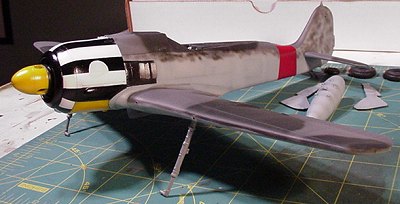 ts of JG-1, with the
checker-nosed Fw190A-6 ‘Black 5’ he is known to have flown in 1943
already represented in my collection by a 1/48th DML kit, I
couldn’t resist the temptation to render this one in his markings as
well.
ts of JG-1, with the
checker-nosed Fw190A-6 ‘Black 5’ he is known to have flown in 1943
already represented in my collection by a 1/48th DML kit, I
couldn’t resist the temptation to render this one in his markings as
well.
Once the major
airframe components had been assembled, the entire model was sprayed with
two coats of Duralite brand flat grey automotive primer. Once dry, this
was given a protective coat of Future brand acrylic mixed 50:50 with 70%
isopropyl alcohol. Then the model was coated with an overall treatment
of Model Master aluminum non-buffing metallizer and sealed with another
coat of Future. In order to facilitate the masking process, I painted
the lower cowl with Floquil’s RLM04 Yellow and the area for the red RVD
band in Model Master Insignia Red with a drop of yellow to increase its
vibrancy just a bit. The lower cowl was then masked, the upper part
painted white, and 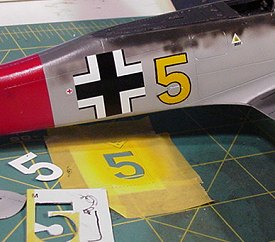 then the black stripes added over that. Once dry, all
these features were masked and the undersides and fuselage painted in
Model Master RLM76. Floquil RLM75 gray violet was next on the upper
surfaces in the usual places and this was masked off for the application
of Floquil’s RLM74 gray green. I usually add a few drops of US Navy Dark
Sea Blue to deepen the tone of their RLM74, which in my opinion is too
light and too green unless you’re modeling a sun bleached
Mediterranean-based Bf109G-5 or 6 from JG27 or JG53.
then the black stripes added over that. Once dry, all
these features were masked and the undersides and fuselage painted in
Model Master RLM76. Floquil RLM75 gray violet was next on the upper
surfaces in the usual places and this was masked off for the application
of Floquil’s RLM74 gray green. I usually add a few drops of US Navy Dark
Sea Blue to deepen the tone of their RLM74, which in my opinion is too
light and too green unless you’re modeling a sun bleached
Mediterranean-based Bf109G-5 or 6 from JG27 or JG53.
I couldn’t find a black trimmed Yellow 5 of the correct size or style on any available 1/32nd decal sheet, so I used plain yellow spares as an airbrush template, then trimmed the numbers with a black ink using a disposable Pigma drafting pen. Insignia and the JG1 badge were from Eagle Strike, while all of the stencils and WrNr were sourced from Mike Grant’s excellent decal sheet.
|
CONCLUSIONS |
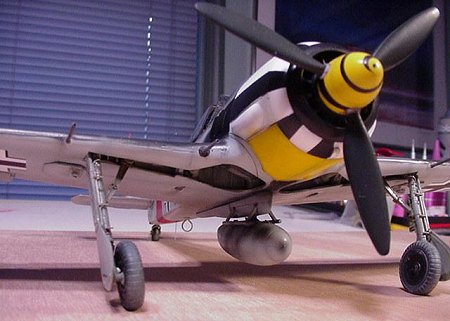 I believe that
the Rutman Fw190A-8 is the finest kit of any kind yet produced for the
type in 1/32nd scale. Sadly, Mr. Rutman announced the closure
of his business and an end to his excellent line of large-scale resin
kits at the end of 2003. The styrene giants will have a tough act to
follow if they are to equal his products either in accuracy or detail.
This kit also served as an excellent primer for me in entering the field
of all-resin construction- it is so well designed and forgiving that no
amount of my ham-fisted methodology caused significant harm. I would
heartily recommend this kit to anyone yearning to add a big Wurger to
their collection of 1/32nd scale models if it can be found.
I believe that
the Rutman Fw190A-8 is the finest kit of any kind yet produced for the
type in 1/32nd scale. Sadly, Mr. Rutman announced the closure
of his business and an end to his excellent line of large-scale resin
kits at the end of 2003. The styrene giants will have a tough act to
follow if they are to equal his products either in accuracy or detail.
This kit also served as an excellent primer for me in entering the field
of all-resin construction- it is so well designed and forgiving that no
amount of my ham-fisted methodology caused significant harm. I would
heartily recommend this kit to anyone yearning to add a big Wurger to
their collection of 1/32nd scale models if it can be found.
February 2004
|
REFERENCES |
Caldwell, Donald. “JG26 Top Guns Of The Luftwaffe” (Orion Books, 1991)
Campbell, Jerry. “Focke Wulf Fw190 in Action” (Squadron-Signal #19, 1975)
Mombeek, Eric.
“Defending The Reich: The History Of Jagdgeshwader 1 Oesau”
(JAC Publications, 1992)
Mombeek, Forsyth,
and Creek. “Sturmstaffel 1 Reich Defense 1943-1944 The War
Diary” (Classic Publications, 1999)
Nowarra, Heinz. “Aircraft & Legends: Fw190 (Haynes, 1988)
Copyright ModelingMadness.com. All rights reserved. No reproduction in part or in whole without express permission.
If you would like your product reviewed fairly and quickly, please contact the editor or see other details in the Note to Contributors.